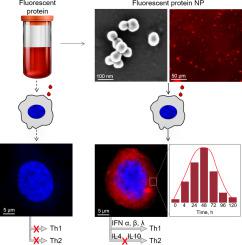Nanomedicine: Nanotechnology, Biology and Medicine ( IF 5.4 ) Pub Date : 2020-08-25 , DOI: 10.1016/j.nano.2020.102293 Olga V Morozova 1 , Anastasia I Sokolova 2 , Elizaveta R Pavlova 3 , Elena I Isaeva 4 , Ekaterina A Obraztsova 5 , Ekaterina A Ivleva 6 , Dmitry V Klinov 3

|
Intracellular delivery of protein nanoparticles (NP) is required for nanomedicine. Our research was focused on the quantitative analysis of protein NP intracellular accumulation and biodegradation in dynamics along with host cytokine gene expression. Fluorescent NP fabricated by nanoprecipitation without cross-linking of bovine serum albumin (BSA) and human immunoglobulins (hIgG) pre-labeled with Rhodamine B were non-toxic for human cells. Similar gradual uptake of the NP during 2 days and subsequent slowdown until background values for 5 days for human cell lines and donor blood mononuclear cells revealed that NP internalization was neither cell-type nor protein-specific. NP delivery into cells was inhibited by homologous and heterologous NP but did not depend on the presence of BSA or hIgG in culture media. The protein NP internalization induced interferon α, β, λ but neither γ nor interleukin 4 and 6 gene expression. Accordingly, cellular uptake of non-toxic protein NP induced Th1 polarized innate response.
中文翻译:

蛋白质纳米颗粒:细胞摄取、细胞内分布、生物降解和细胞因子基因表达的诱导。
纳米医学需要蛋白质纳米颗粒 (NP) 的细胞内递送。我们的研究重点是对蛋白质 NP 细胞内积累和动态生物降解以及宿主细胞因子基因表达的定量分析。通过纳米沉淀制备的荧光 NP 没有交联牛血清白蛋白 (BSA) 和用罗丹明 B 预标记的人免疫球蛋白 (hIgG),对人体细胞无毒。在 2 天内类似的 NP 逐渐吸收和随后的减速直到人类细胞系和供体血液单核细胞的 5 天背景值显示 NP 内化既不是细胞类型也不是蛋白质特异性。NP 向细胞的传递受到同源和异源 NP 的抑制,但不依赖于培养基中 BSA 或 hIgG 的存在。蛋白质 NP 内化诱导干扰素 α、β、λ,但不诱导 γ 和白细胞介素 4 和 6 基因表达。因此,细胞摄取无毒蛋白质 NP 会诱导 Th1 极化的先天反应。


























 京公网安备 11010802027423号
京公网安备 11010802027423号